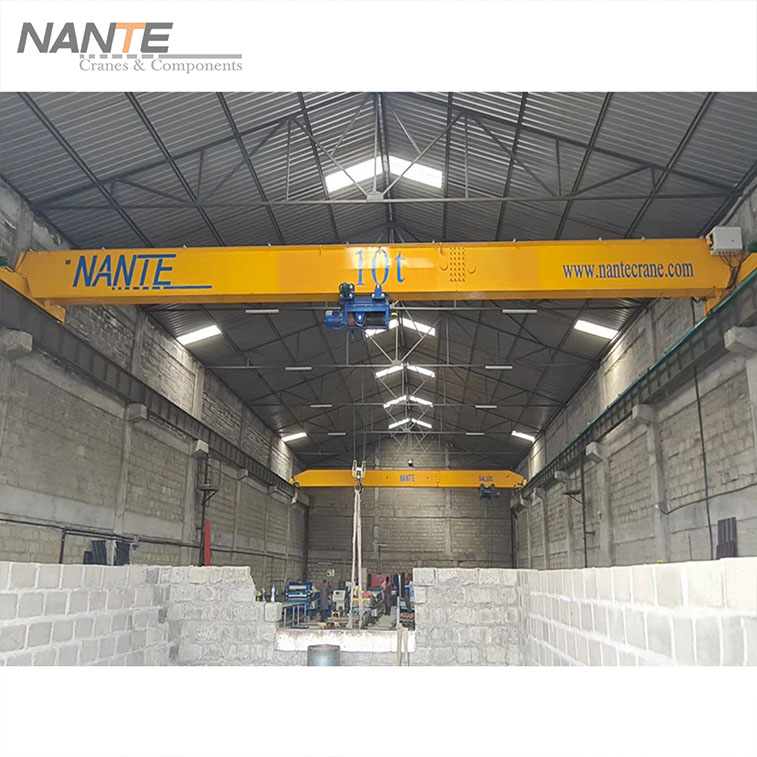Types of Cranes Discover the Varieties for Different Industries
Date: 2024-07-04 Share:
Cranes are an indispensable part of many industries, providing the muscle required to lift and move heavy loads with precision and efficiency. The diversity in crane types is driven by the different needs of various sectors, from construction to manufacturing to shipping. Let’s delve into some of the most common varieties of cranes, exploring their distinct features, applications, and advantages.

Overhead Crane
Definition and Structure
Overhead cranes, often known as bridge cranes, are utilized extensively in industrial environments. These cranes are composed of a rigid steel structure that includes a bridge beam, a trolley, and a hoist. The bridge runs along parallel runways along the walls of the plant or workshop, and the hoist travels along the bridge. This configuration allows the crane to move loads horizontally and vertically within a defined space.
Common Applications
Overhead cranes are predominantly used in manufacturing and maintenance facilities. They are essential in assembly lines, metal fabrication, and machining environments where heavy components need to be moved with high precision. Additionally, overhead cranes are widely employed in warehouses for handling bulky goods and in shipyards for managing ship parts and large equipment.
Advantages and Limitations
One of the primary advantages of overhead cranes is their ability to lift extremely heavy loads, often up to several hundred tons, which makes them perfect for heavy industry applications. They also significantly improve efficiency and safety by minimizing manual handling of heavy objects. However, overhead cranes have limitations, including high installation and operational costs. Their fixed path also restricts the range of motion to designated areas, making them less flexible than mobile cranes.
Gantry Crane
Basic Features and Design
Gantry cranes are characterized by their A-frame structure, where the crane bridge is supported by two or more legs that run on a rail or track system installed on the ground. Unlike overhead cranes, gantry cranes do not require runway beams and can be erected outdoors. Some gantry cranes are equipped with tires, making them mobile and more versatile for various applications.
Uses in Various Industries
Gantry cranes are highly versatile and find applications in multiple industries. In heavy manufacturing and transportation sectors, these cranes are used to lift enormous components such as ship engines, locomotives, and steel beams. In construction sites, gantry cranes help in moving concrete blocks, pipes, and other heavy materials. They are also popular in shipyards for loading and unloading cargo and in aerospace for handling large aircraft parts.
Benefits and Drawbacks
One of the major benefits of gantry cranes is their mobility, especially those equipped with wheels, which allows them to be easily relocated to different areas as needed. They also provide the capability to lift heavy loads without the need for runway beams, which can reduce setup costs. However, gantry cranes can be cumbersome due to their size and may require significant open space for operation. Additionally, they can be affected by weather conditions when used outdoors, posing potential challenges to their consistent performance.
As one of the famous brands in the production of winches, cranes and crane parts, Nante Crane is dedicated to research and development of lifting and material handling technologies. We adopt innovative ideas and design in developing new products and services. Backed up by a wealth of industrial experience, we can provide customers with high quality lifting equipment and components.
Construction Crane
Types of Construction Cranes
Tower Crane
Tower cranes are fixed cranes mounted on a tall, sturdy tower that provides height and lifting capability required for constructing tall buildings and structures. These cranes are equipped with a jib that rotates around the mast, allowing for a wider radius of operation. The combination of height and reach makes tower cranes ideal for high-rise construction, where lifting heavy materials to great heights is essential.
Mobile Crane
Mobile cranes are versatile lifting machines mounted on trucks or wheeled vehicles, enabling them to travel across different sites and terrains. This mobility allows for quick setup and easy relocation within a construction site. Mobile cranes can vary in size and capacity, from smaller cranes used for light lifting to larger units capable of handling very heavy loads, making them suitable for a wide range of construction projects.
Crawler Crane
Crawler cranes feature tracks instead of wheels, offering stability and mobility on rough and uneven terrain. These cranes are particularly useful for heavy lifting tasks in challenging environments, such as soft or muddy ground conditions. The tracks distribute the weight of the crane and the load more evenly, preventing sinking and providing a stable platform for lifting operations.
Application in Construction Projects
Construction cranes are crucial for various tasks such as lifting steel, concrete, and other building materials to desired heights. Tower cranes are essential for high-rise building construction, given their height and reach capabilities. Mobile cranes are ideal for general construction and short-term projects, thanks to their easy mobility and quick setup. Crawler cranes are utilized for heavy-duty lifting on challenging terrains, making them invaluable for tasks that require stability and strength in less-than-ideal conditions. Each type of construction crane is chosen based on the specific needs and constraints of the project, ensuring that the right equipment is used for the job.
Safety Considerations
Operating construction cranes requires stringent adherence to safety measures to mitigate risks. Proper training and certification for operators are crucial to ensure that cranes are used correctly and safely. Regular maintenance checks and inspections help identify and address any potential issues before they become serious problems. Adherence to load limits is essential to prevent overloading and potential structural failure. Additionally, establishing clear communication protocols on construction sites helps in preventing accidents and enhancing overall project safety. Ensuring that all personnel involved in crane operations are aware of and follow safety guidelines is key to maintaining a safe working environment.
As one of the famous crane production and manufacturing brands, Nante Crane is committed to helping our clients reduce investment cost, improve production efficiency, and economize energy consumption. Nante Crane’s main products include industrial cranes, offshore cranes, Launching Crane, electric hoists, crane travel unit, mobile power supply system etc. with reliable and excellent performance.
Workstation & Offshore Crane
Overview of Workstation Cranes
Design and Capabilities
Workstation cranes are compact cranes designed to assist in lifting and moving loads within a specific workstation or smaller area. These cranes often feature lightweight materials and ergonomic designs, allowing them to be easily operated by a single worker. The simplified structure and user-friendly controls are tailored for frequent use, making them essential tools for enhancing workflow efficiency in various industries.
Primary Uses
These cranes are primarily used in manufacturing and assembly environments where precision and repeatability are paramount. They enable workers to lift heavy components without physical strain, thereby enhancing productivity and reducing the risk of workplace injuries. Common applications include lifting automotive parts in car manufacturing, assembling electronic components in tech industries, and handling tools and dies in a machine shop. The compact size and tailored functionality make workstation cranes ideal for tasks that require careful manipulation and consistent performance.
Overview of Offshore Cranes
Structural Layout
Offshore cranes are robust cranes engineered to withstand harsh marine conditions. They often feature corrosion-resistant materials and advanced structural designs to maintain stability and reliability on oil rigs, ships, and other offshore platforms. The design typically includes reinforced steel components, hydraulic systems for precise control, and safety features that protect both the crane and operators from the challenging offshore environment.
Typical Operations
These cranes are used for various offshore operations such as loading and unloading supply vessels, handling subsea equipment, and assisting in oil and gas production activities. Their ability to operate in challenging sea conditions makes them indispensable in the offshore energy sector. Offshore cranes are also involved in the installation and maintenance of wind turbines, contributing to the growing renewable energy industry. Their versatility and durability ensure that they can perform a wide range of tasks, from heavy lifting to delicate handling, in some of the most demanding conditions on the planet.
In addition to producing and manufacturing cranes, Nante Crane has achieved breakthroughs in core technology and has the ability to manufacture core components, which are widely used in more than 20 professional fields such as advanced manufacturing, metal processing, aerospace, etc. Nante Crane is committed to the research and development and manufacturing of handling machinery and technology.
Summarizing the Types of Cranes
Cranes come in various designs tailored to meet the diverse needs of different industries. From the fixed and robust overhead and gantry cranes used in industrial settings, to the versatile construction cranes and specialized workstation and offshore cranes, each type offers unique advantages and addresses specific challenges. Understanding these varieties helps industries choose the right crane, boosting productivity while ensuring safety and efficiency in operations. As technology and engineering continue to evolve, the future will undoubtedly bring more innovative crane designs catering to even more specialized applications.
 English
English






